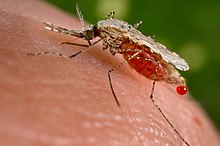
Back أنوفيلة Arabic انوفيليس ARZ Anopheles AST Малярыйныя камары Byelorussian Анофелеси Bulgarian Anopheles Catalan Anopheles CEB Anofeles Czech Anopheles German Anopheles Spanish
| Anopheles | |
|---|---|

| |
| Anopheles stephensi, female | |
| Scientific classification | |
| Domain: | Eukaryota |
| Kingdom: | Animalia |
| Phylum: | Arthropoda |
| Class: | Insecta |
| Order: | Diptera |
| Family: | Culicidae |
| Subfamily: | Anophelinae |
| Genus: | Anopheles Meigen 1818 |
| Species | |
|
For a full description, see the main article: Taxonomy of Anopheles | |
Anopheles (/əˈnɒfɪliːz/) is a genus of mosquito first described by J. W. Meigen in 1818, and are known as nail mosquitoes and marsh mosquitoes.[1] Many such mosquitoes are vectors of the parasite Plasmodium, a genus of protozoans that cause malaria in birds, reptiles, and mammals, including people. The Anopheles gambiae mosquito is the best-known species of marsh mosquito that transmits the Plasmodium falciparum, which is a malarial parasite deadly to human beings; no other mosquito genus is a vector of human malaria.
The genus Anopheles diverged from other mosquitoes approximately 100 million years ago (mya), and, like other mosquitoes, the eggs, larvae, and pupae are aquatic. The Anopheles larva has no respiratory siphon through which to breathe, so it breathes and feeds with its body horizontal to the surface of the water. The adult mosquito hatches from the surface and feeds on the nectar of flowers; the female mosquito also feeds on blood, which animal diet allows them to carry and transmit parasites between hosts. The adult's feeding position is head-down, unlike the horizontal stance of the culicines. Anopheles are distributed almost worldwide, throughout the tropics, the subtropics, and the temperate regions of planet Earth. In hot weather, adult Anopheles aestivate, which is a state of dormancy that enables the mosquito to survive in hot dry regions, such as the Sahel.
- ^ "Nail Mosquito". United States Fish and Wildlife Service. Retrieved 16 December 2023.
Common Name: Nail Mosquito, marsh mosquitoes
© MMXXIII Rich X Search. We shall prevail. All rights reserved. Rich X Search